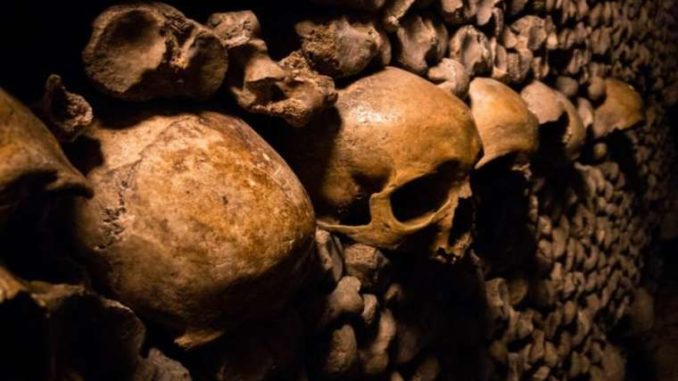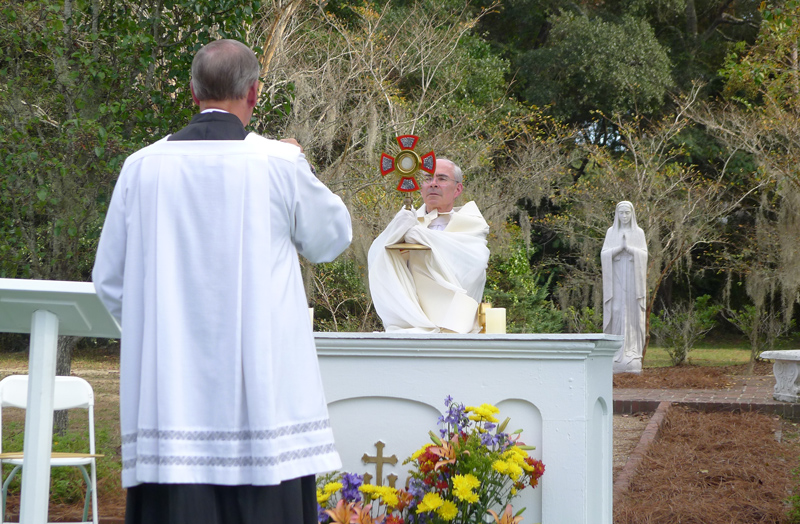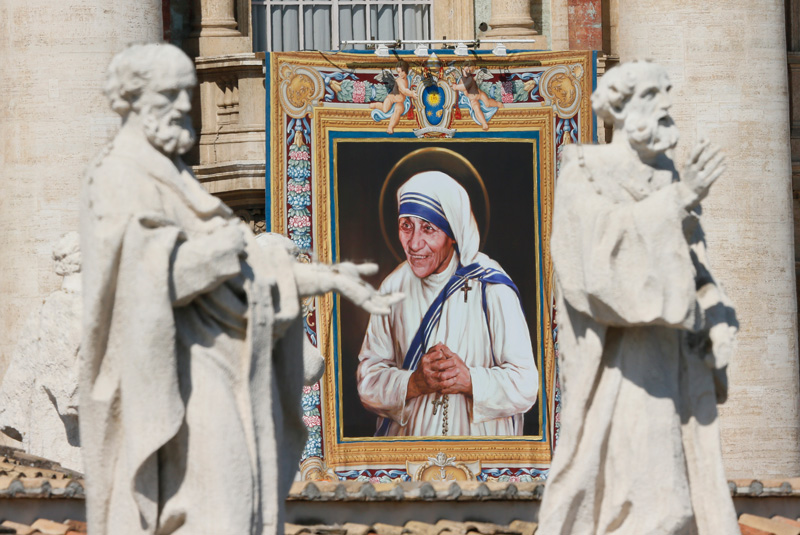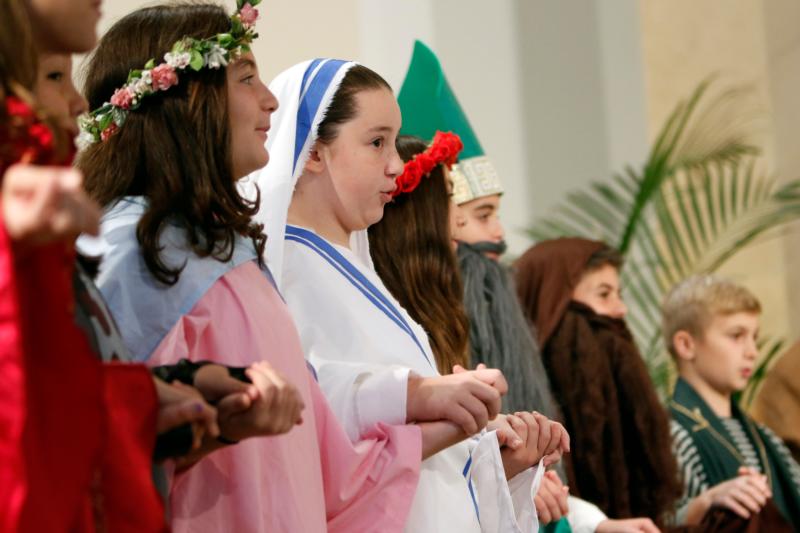
“Following watching that film, a conversation was initiated by the teens, very enthusiastically, where they talked about, ‘Wow. Instead of learning about poets and writers as they did in the film, let’s learn about the lives of the saints who we don’t know a lot about.’”
Cotter’s students said they could recognize certain saints’ images in icons or statues, but beyond that, they did not know about their lives. “What were they like? How did they live? How did they die?” Cotter said.
That conversation inspired the founding of the “Dead Theologians Society”, a youth group format that has been used by parishes throughout the United States, now in its 23rd year.
The group thought the name “Dead Theologians Society” was apt not only because of the film, but because “we’re learning about people who are only dead by the world’s definition of dead, but they’re fully alive in Christ,” Cotter said.
“Dead to sin but alive in Christ” became the motto of the newly-formed group, and they decided to meet weekly for two hours to learn about the lives of the saints and to pray for souls in purgatory.
Cotter said a typical Dead Theologians Society (DTS) chapter will meet weekly for two hours. The first half-hour is reserved for socializing, after which the students move into a chapel or a designated prayer space. Taking a cue from the style of Dead Poets Society, the room is typically dark, lit only by candles or smaller lights, and decorated with icons.
“Many parishes … they’ll set up a room and make it look like a little monastery. They’ll have a crucifix, maybe some Byzantine hanging lights in front of icons, and they make it prayerful. It’s not spooky, it’s not macabre. It’s just a very prayerful and very sacred space,” Cotter said.
Once the meeting in the prayer room begins, a facilitator tells the story of the life of a saint to the group for about 20 minutes, followed by time for questions from the students about the saint or about the faith. This is followed by praying a mystery of the rosary, which is then followed by the group’s signature prayer, the St. Gertrude Prayer for Souls in Purgatory: “Eternal Father, I offer Thee the Most Precious Blood of Thy Divine Son, Jesus, in union with the Masses said throughout the world today, for all the holy souls in purgatory, for sinners everywhere, for sinners in the universal church, those in my own home and within my family. Amen.”
The prayer carries with it a promise that “a thousand souls are released every time this prayer is prayed sincerely,” Cotter said.
The number of souls is not exact, he added, “it’s not like there’s a total board that we have running at the national office. But we know that we have thousands of young people sincerely praying for souls, Lord only knows probably how many souls we have benefited. Padre Pio said, ‘We must empty purgatory,’ and our prayers help that to happen.”
The meeting then concludes with prayers for specific intentions of members of the group, and the Divine Praises. Afterward, parents of the members typically provide snacks. Cotter said many groups try to get as much parental involvement as possible, and that the timing of the meetings allows the parents to have their own holy hour before setting out food for the group.
From its beginning, DTS has had a profound impact on the students and parents connected to the group.
“In the first two years, we had 16 Protestant kids come into the Church, become Catholic, and one was a Protestant minister’s kid. That’s how effective it was,” Cotter said.
There were also conversions from parents, Cotter said, who hear about the group from their kids, who often bring home a prayer card or a medal of the saint of the week.
Cotter recalled the conversion of a father who, when his daughter (in DTS) went home, “she was talking about the proofs of the existence of God from St. Thomas Aquinas. And her father actually came back into the church … he thought he was too intellectual to believe in God and his high school daughter kind of set him straight in a very loving way. But it turned his life around.”
The DTS also gives confirmation students a chance to learn about the saints before they choose one for confirmation, Cotter said.
The group has also inspired numerous vocations to the priesthood and religious life.
“In the last six months I’ve either met or learned of about 15 priests, three seminarians, and a nun, who were all in DTS in different parts of the country when they were teenagers and they all credit DTS as having a major impact in them finding their vocation,” Cotter said.
One of those priests is Father Raymond Snyder, a Dominican friar and priest who serves at St. Patrick Church in downtown Columbus, Ohio.
As a teenager, Snyder joined the local DTS chapter at his home parish in Wichita, Kansas. He was not involved in his high school youth group, he noted, because as a Catholic school student he already had several other religious commitments. But DTS captured his attention, he said, and he remembered the saint stories being particularly compelling.
“(The leaders) were very good at presenting the saints in a convincing way and in a powerful way, and using that witness, that story and model of the saints to tell us something about our faith,” Snyder told CNA.
Snyder said that one of the most memorable moments of joining DTS was when he was given his hoodie. The DTS hoodie is only available to members of the group who have come for at least three consecutive meetings and is not sold publicly on the DTS website. They are black, with a small monstrance embroidered on one corner.
“It’s sort of like a habit, like a religious habit almost. It reminds one of that at least,” Snyder said. “It was a sort of a little bit of a rite of passage and something to kind of increase that ownership in the group.”
At the moment of induction, members promise to pray the St. Gertrube prayer for the souls in purgatory. Praying for souls in purgatory is an important practice of the Church, he added, so much so that the entire month of November is dedicated to praying for them.
“We’re reminded to pray for not just the souls in general, but to remember our loved ones who have died and gone before us,” he said.
The aesthetic of DTS — candle-lit rooms, icons, a prayerful and sacred space — was important too, he said.
“The more things are bound up with our imagination and vivid memories, the more we remember them, which is part of why the liturgy has such an important place for us, and the practice of the faith to continually be reminded about the realities we cannot see,” he said.
After graduating high school, Snyder made the St. Gertrude prayer a part of his daily routine, “which may not sound all that remarkable,” he said, but over time it shaped his prayer life and vocation.
“It begins to be a practice in one’s life, it almost adds to that contour and the shape of one’s life and vocation,” he said.
Snyder said he started thinking about the priesthood “around my freshman, sophomore year of high school, which is when I would’ve been involved in this group, and I began thinking about the priesthood and religious life specifically. It was a part of the whole ensemble of what God had for me at that time and for which I’m grateful now.”
Father Jack Fitzpatrick, who serves as parochial vicar at St. Paul’s Parish in Colorado Springs, also credits DTS with influencing his faith formation in high school.
A kid from a small town, he said there wasn’t much going on youth-group-wise in his own hometown, but that he had a few friends from a nearby town involved in a chapter of DTS.
“They were telling me that their youth group was kind of serious, actually, there were a lot less icebreakers … and that really fit me pretty well. I wasn’t really looking for games and things like that, I kind of wanted to go deeper into my faith,” he said.
“And so anyway, some of these friends of mine invited me to that Dead Theologians Society and I went and it was just awesome. It was kind of exactly what I was looking for.”
The saint stories told by the leaders were done in a somewhat “dramatic fashion,” he said, and the candle-lit room with holy pictures “lent itself to a more solemn feel … something about the aesthetic really did it.”
“It was supposed to mimic the environment of the catacombs in the early Church,” he said, “And the idea was, a group of Christians coming together to be encouraged by the virtue of other Christians who had gone before. You know, because that’s the whole reason why … the early Christians went to the catacombs, because the martyrs were buried there. And they thought, ‘Boy, if we can learn from the courage of these holy men and women who have gone before then we can really be in good shape.’”
Fitzpatrick said he liked the more solemn and traditional feel of DTS compared to other youth groups at the time.
“The Dead Theologian Society really relied on a lot of traditional elements of our faith. Sacramentals were really important. We were all invested in the Brown Scapular. We had this hooded jacket that we wear that the priest would bless when we had earned it. And … there’s just a lot of traditional elements in the Dead Theologian Society that honestly, I really didn’t find in whatever the standard youth group in 2003 was,” he said.
Fitzpatrick also continues to recite the St. Gertrude Prayer for Souls today.
“I mean, the promise associated with it is that every time you say this prayer devoutly, a thousand souls will be delivered from purgatory. So, why not? Why not say that prayer as many times a day you can? I think what was really wonderful about learning that prayer, and making it part of my spiritual life was the fact that I don’t know that it had ever occurred to me that certain prayers had different promises attached to them,” he said.
Because Fitzpatrick had never heard of prayers with particular promises, he started researching what other prayers and practices of the Church came with specific promises. It led him down a path of searching for and discovering many treasures of the faith, he told CNA.
“That prayer really did open a door for me to learn about all kinds of other things in the spiritual life that are a significant benefit, and that people my age certainly would not have been exposed to,” he said.
He said he would recommend DTS to any parish looking for a way to get their young people involved and learning more about their faith.
“Think about incorporating Dead Theologians Society as maybe just a part of your overall youth activities for your parish, because for sure kids out there are looking for what DTS has to offer, and if you offer it to them, boy, they will start to grow, and they’ll come, and it’s just an amazing thing,” Fitzpatrick said.
Cotter said that in his experience, teenagers embrace the idea of praying for the dead as a way to help them to heaven.
“Most teenagers have lived long enough where they’ve lost somebody. It could be their grandparents, a sibling, parents of friends. So they’ve had some experience with death that was painful,” Cotter said.
“And we can tell them, ‘There are things we can do that’s very real that can be of great benefit for the one you’ve lost,’” he added. “They love it and it actually gives great hope. There’s an enthusiasm for it. It’s a great service.”
Cotter said that even though he founded DTS and has traveled the United States and even several countries abroad to spread its mission, few people really know who he is or what he looks like, which is too bad, because he has a pretty incredible bright red mullet.
He said he prefers to keep a low profile.
“There’s probably just a handful of teens out of all the (chapters) ever that know who Eddie Cotter is and that’s fine because this isn’t about me,” he said.
“This isn’t like the cult of Eddie Cotter’s youth group. If I were to pass tomorrow, I mean I’m glad I have people that’ll pray for my soul, from DTS, but the apostolate isn’t based on me. And I like that. The teenagers now that are in DTS, they weren’t even alive when this thing started,” he added.
Cotter said he thinks what makes DTS so appealing to teens, and why it has lasted for 23 years, is that it relies on the traditions of the Catholic Church.
“I think it’s going to keep going because these treasures of our faith are timeless. The shelf life doesn’t have an expiration date on it,” he said.
“Everything we do in DTS is as relevant now as it was 23 years ago, as it was hundreds of years ago, and will be hundreds of years from now. And I think that’s one of the many strengths of the program is it’s not following a trend, trying to out-hip the teen culture. We’re bringing them to our home-field advantage which they’re not going to get in the secular world.”
In 2015, DTS became canonically approved as a private association of the faithful by decree of the late Bishop Robert Morlino from the Diocese of Madison, Wisconsin. Since its founding in 1997, there have been over 18,000 young people in roughly 550 parishes throughout the U.S. and in several foreign countries who have participated in a DTS chapter.
Cotter said learning how DTS has impacted young people is one of the joys of his life. A few years ago, he was at a Catholic conference in Ohio when he was stopped by a van full of nuns who were honking at him. One of them recognized Cotter and had been involved in DTS as a teen.
“I’m blessed far beyond what I deserve because I don’t have a theology degree or anything. I was a youth minister at a parish and thought, ‘Wow, we can do this,’” Cotter said.
“And so that’s why when I very sincerely say: If Eddie Cotter can do this, there’s a lot of people out there that are far more gifted than I am. If they decide to either have a chapter of Dead Theologians Society or do something to help save souls for Jesus, they can do it.”
By Mary Farrow
Kate Olivera contributed to the reporting of this story.



